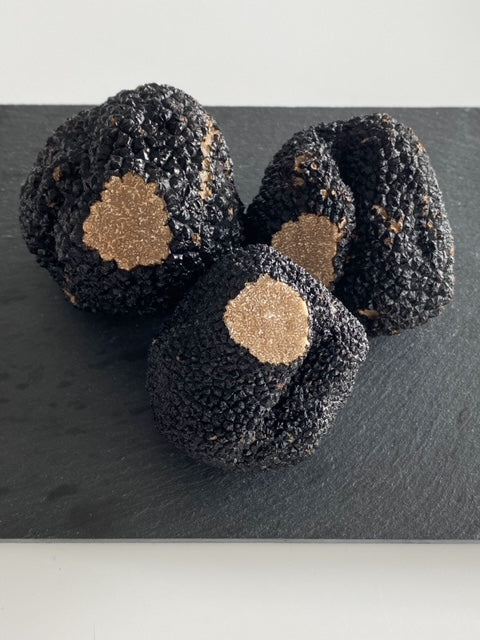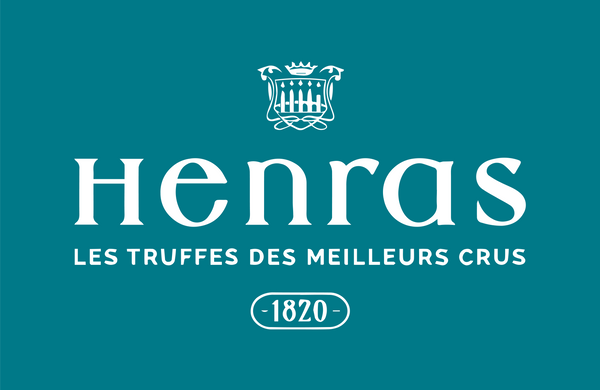
The truffle is renowned for its unique flavor, and often likened to a luxury ingredient, with an unaffordable price. With prices established each week according to supply and demand, its price changes throughout the season. Sometimes not very accessible before the holidays, it can see its price halved in February at the peak of production. If the price fluctuates throughout the 16 weeks of digging, it also evolves strongly from one year to the next, depending on what the harvests give, impacted by various phenomena.
A RARE BUT CAPRICIOUS PRODUCT
If the tuber melanosporum cannot be "cultivated", most of the harvests offered come from truffle fields which are the object of great care by truffle growers .
These truffle fields give very variable yields because many elements influence not only the quantities of truffles produced, but also their quality, which explains the significant price variations .
If today truffle growers know the main influencing factors, they cannot control them all...
We can mention a few well-known ones:
- The quality of tree mycorrhization
- How to care for trees
- The age of the plants
- The biotope
- The pH of the ground
- His exhibition
- Irrigation
- Water drainage
- The number of plants per hectare
- how to position them
- Weather
- The ability to mobilize canine resources for digging
Despite everything, when all these conditions are considered optimal, the truffle grower is not assured of the quality or the size of his harvest: yields can range from 1 to 70 kg per hectare (for 400 trees planted).
In addition, a truffle field ( land on which truffles are harvested) produces on average only from its 7th year and no more than 5 years thereafter .

As a result, supply and demand on the truffle market do not always balance each other. From one season to another, demand can be much higher than supply, causing a significant increase in selling prices .
The black truffle market is also experiencing a paradox : the demand is very high throughout December, at the very beginning of the black diamond season , when the truffles are not quite ripe yet, then it then drops in January, February and March so its price does the same, while the truffle is at its peak of maturity in February.
A PRODUCTION THAT IS NOT GUARANTEED EVERY YEAR
As you will have understood, the factors allowing the truffle to form are complex, which is why its price is so high . However, the truffle is not a product like the others. The birth of the truffle requires conditions that cannot, today, all be controlled by humans. A part of mystery always resides to hope to succeed in cultivating the truffle , as one would cultivate another food.
Some seasons, when truffles are rare, their price per kilo becomes very high and unfortunately, the product is often less qualitative compared to more fruitful harvests. The larger the harvests, the lower the prices and the better the truffle!
A PRODUCT THAT NEEDS TO BE WORKED BEFORE BEING CONSUMED
The truffle is not a dish that can be eaten fresh out of the ground. Before being able to move on to tasting, these are first meticulously processed.
Cleaning, selection and assessment of maturity take time and require experts in this field to judge the quality of these products: this is the business of Maison Henras and this is the added value that we bring to professionals, but also to our individual customers.
It all starts with the cleaning, which with us is done by hand, truffle after truffle , in order not to damage the product. While some have mechanized this step to save time, we have chosen to continue brushing the truffles by hand to preserve their integrity. This particular care makes it possible not to "rush" the product which will "hold" better over time. This explains the slightly higher price.
In general, we lose at this stage between 5 and 10% of the weight harvested in the ground.

Then comes the canifage , an essential step which aims to allow the experts to gauge the level of maturity of the tuber . Using a specially adapted knife, a notch is made on the edge of the truffle to facilitate inspection of the gleba (truffle flesh). The expert analyzes its color, its veins but also the firmness of the truffle , its density and defines at this time if it deserves to be offered for sale:
- If it is judged to be sufficiently ripe and its integrity is preserved (no worms, attack or injury), it will be categorized according to its size and quality (Extra which is the one with the highest price, 1st Choice, Pieces ) .
- If it is pruned, damaged parts are cut off, it will become a piece. If it is regular, round, mature as desired, without holes, it will be offered as an Extra.
For more than 200 years, within Maison Henras, the same delicate gestures have been reproduced each season to offer the public very high quality truffles . Our experienced team carries out this artisanal work with the greatest involvement, respecting the product.
This long, delicate, precise and meticulous work allows us to offer our truffles in the great starred restaurants, all over the world, with quality regularity throughout the season, thus ensuring the chefs the best product.
We are particularly happy to help preserve this centuries-old know-how, and to help make Tuber Melanopsorum an exceptional ingredient that is part of the heritage of French gastronomy.
WHERE TO BUY TRUFFLES
- In truffle markets, retail
Truffle markets are places where truffle growers or harvesters can sell directly to individuals. Since the truffles are not yet ready for tasting and all the preparation work (cleaning, sorting and selection) has not been completed, the prices offered may seem attractive.
Visitors buy "all comers", in the ground, which can hold very good surprises, but sometimes also bad surprises (frozen, wormy, holey, earthy, old truffles), despite the good faith of the sellers... The experience and the folklore are however worth the detour, but plan to go early, the quantities are often limited.
- Within trading houses and processors of canned truffles
Trading houses such as Maison Truffes Henras buy truffles from truffle growers in plots of land. These batches contain a random quality of truffles, for example it happens that some batches only have 5% of truffles which can be classified as "Extra" and that the rest is declared not optimal for sale, containing only wormy truffles , or whose maturity is not ideal.
After reception, the selection process therefore often leads us to reject many truffles which will then be transformed into preserves, after special handling aimed at removing the damaged parts. These steps explain why the prices offered are higher than on the markets, but they ensure optimum quality.
WHICH PRICES FOR WHICH TRUFFLES?
Maison Truffes Henras works mainly with tuber melanosporum (known as the Black Truffle of Périgord), from the beginning of December to the end of March, but there are other species of truffles whose prices are very different.

The most expensive truffles are the white truffles of Alba (Tuber Magnatum), with a price that can reach up to 5000€ per kilo . These are harvested from October until the end of December. These wild truffles grow in Italy and Bulgaria. They are eaten raw and have a very particular flavor, strongly alliaceous.

Summer truffles or St Jean truffles (Tuber Aestivum) are estimated between 100 and 200€ per kilo . The first fresh summer truffles appear during the month of May until August. Much less aromatic than the Truff e Noire du Périgord , it can only be eaten raw and tends to spoil very quickly. It grows in France, Romania and Bulgaria.

The Tuber Uncinatum , the so-called Burgundy truffle , is a subspecies of the summer truffle which is harvested from September to October. The price of this truffle is on average €400 per kilo for these "grey" truffles which have more marked aromas than their summer cousin, without however equaling the black diamond...

